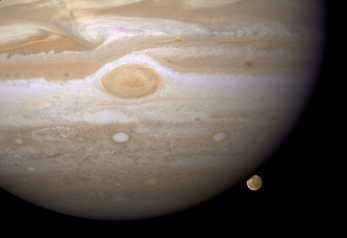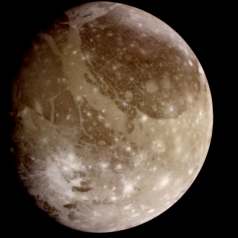JUICE's primary target: Ganymede
 |
 |
| Jupiter and Ganymede. Credit: NASA, ESA and E. Karkoschka (University of Arizona) | Ganymede. Credit: NASA/JPL |
Ganymede is the primary scientific target of the mission. With a diameter of about 5260 km, larger than that of Pluto and Mercury, Ganymede tops the Solar-System moons' size chart. It is the seventh moon from the gas giant (and the third among the Galilean satellites) and orbits Jupiter at a distance of more than 1 million kilometres. Researchers believe there is tidal heating on Ganymede, although to a much smaller degree than on Io and Europa. This heat could drive some tectonic activity and provide one of the necessary conditions for life to emerge: a source of energy.
Mysterious magnetic field
One of Ganymede's most remarkable features is its intrinsic magnetic field, discovered by the Galileo mission. No other moon in the Solar System is known to have one, and only two other solid bodies (Mercury and the Earth) generate magnetic dipole fields. Ganymede's miniature magnetosphere lies within Jupiter's much larger magnetosphere, with complex interactions happening between the two. JUICE aims to study these interactions in detail. This includes looking into how particles in the near-Ganymede space environment affect the composition of the moon's surface, how auroras develop on the satellite, and how Ganymede's magnetic field influences auroras on Jupiter. To do this, some of the mission's instruments will measure the moon's magnetic field, both its intrinsic component and that induced by Jupiter. Other instruments will characterise the plasma environment around the moon, studying the particles in it, and will investigate the outer layers of the moon's thin atmosphere.
 |
| Illustration of aurorae on Ganymede. Credit: NASA, ESA, and G. Bacon (STScI) |
Hidden ocean
The Galileo spacecraft's measurements of Ganymede's magnetic field suggested there could be a subsurface layer of salt water, which unlike ice is a good conductor of electricity. However, this evidence was not conclusive because of the complex interactions between the magnetic fields of Jupiter and Ganymede. More recent observations of Ganymede's auroras made with the Hubble Space Telescope further hinted at the existence of the under-ice ocean. As such, scientists now have firm evidence that Ganymede, like Europa, conceals an ocean under its icy shell, one that may contain more water than all surface water on Earth combined.
However, we still don't know at what depth this ocean starts, how far down it extends, and how it interacts with both the deep interior of Ganymede and the icy crust above it. Finding out more about Ganymede's liquid layer, including its composition and conductivity, is a main objective of JUICE since the ocean might be habitable.
The mission's instruments will make detailed measurements of Ganymede's magnetic field and determine the electric currents at the moon to constrain the extent and conductivity of its subsurface ocean. JUICE will also use other techniques to find out the size of the liquid layer and the icy crust. These include detailed measurements of the moon's rotation rate, and well as a precise determination of Ganymede's gravity field, and of shape and surface changes at the moon due to Jupiter's tidal influence.
A complex core
Scientists hope these measurements will help them find out more about the composition and interior structure of Ganymede. With a mass about half of Mercury's and a diameter greater than that planet's, the moon has a relatively low density, indicating that it's made up of both rocks and ices. In addition, the magnetic-field data from Galileo points to the existence of a liquid, iron-rich core. JUICE will reveal more about the thickness of the various layers in the moon's interior and their composition, which will improve our understanding of how the moon evolved and how it was able to acquire its differentiated structure. JUICE's measurements will also help us find out more about how Ganymede's core is able to generate and maintain a magnetic field.
Investigating the ice
Another of JUICE's objectives is to explore and characterise Ganymede's icy crust, which will be a completely new science endeavour. The mission will use an ice-penetrating radar to probe the moon's subsurface down to a depth of about 9 km. The aim is to determine the crust's minimum thickness, possibly detect liquid water in the shallow subsurface, and explore the moon's tectonic features and geological evolution.
In addition to the subsurface studies, the mission will explore the very top of the icy shell. Ganymede's surface has very old, dark, and densely-cratered regions (like most of Callisto), as well as lighter, younger, grooved regions (more similar to Europa's surface). The intricate pattern of grooves and ridges on Ganymede is thought to be due to tectonic activity, though icy volcanism could also have played a role in the formation of these regions. JUICE will combine stereo imaging and laser altimetry to investigate the moon's surface and determine the geological processes that helped shape it. The spacecraft will also carry out high-resolution investigations of selected regions on Ganymede's surface to better understand the local geology.
 |
| Ganymede global geologic map and global image mosaic. Credit: USGS Astrogeology Science Center/Wheaton/NASA/JPL-Caltech |
Searching for biosignatures
This high-resolution mapping of the surface can help constrain the moon's composition and mineralogy, and assess how habitable Ganymede could be by searching for biosignatures. Observations at various wavelengths will allow astronomers to study non-water-ice material to determine the distribution of biologically essential elements—such as carbon or oxygen—and other important elements—such as magnesium and iron—on the planetary body. The mission will also shed light on the origin and evolution of the materials on the surface by exploring which substances form at Ganymede and which are brought in from the plasma environment around the moon.
To study Ganymede in detail, JUICE will enter orbit around it, becoming the first spacecraft to orbit a moon in the outer Solar System. The dedicated orbital tour is expected to last about eight months and will be the final stage of the mission.
